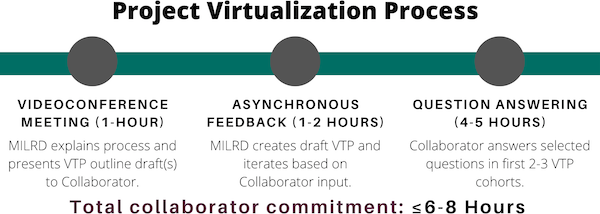Create a VTP with Us
If you're interested in creating a public VTP or developing a private, custom-built VTP tailored specifically for your organization, please contact us at [email protected].
Creating a VTP on our platform typically takes ≤ 8 hours of collaborator time in total—provided code and data are accessible and organized.

Public VTP Benefits
We are keen to create VTPs in partnership with labs and release them simultaneously with the associated publications. This fosters communities that can learn new methods, reproduce work, and explore related professional domains together.
- Postdocs, PhD students and Staff Research Scientists can virtualize their recent work (e.g. published papers & methods) to promote it and their groups/orgs.
- VTPs offer a way for folks in the research community to reproduce a publication's results and learn the utilized methods.
- VTPs help aspiring scientists and professionals (down to the high-school level) to explore occupational domains.
Feedback from Virtualization Collaborators
“It took less than four hours to work with MILRD to virtualize the habenula/scRNA-seq project. We used a combination of Zoom and asynchronous communication on Slack. MILRD did most of the heavy lifting. By the time I published the paper, most of the work on my end (e.g. making the data publicly available) was already done. The process wasn’t a burden at all.
During the first cohort, I spent an hour presenting and answering questions in the group Zoom call and ~2 hours asynchronously answering questions on the group channel.
Doing the Zoom call and answering participant questions in the group channel was convenient and easy. I actually found the Zoom conversation to be quite fun. As a scientist who spends a lot of time working on this stuff, I’m excited when people are interested enough to ask detailed questions about the work.
A big reason I was motivated to participate in this was because I felt I needed to do more science outreach. It’s more salient than ever that we be advocates for science. We need to make sure people have the ability/tools to process complex information, and that folks of different backgrounds have access to robust science enrichment and training opportunities.
I think this project has gone really well and the feedback from participants who completed it has been great. For example, a postdoc in my lab enrolled in this VTP and she said it was super helpful.”
“Working with MILRD to virtualize the Social Mobility VTP was straightforward and we enjoyed the experience. MILRD came to the table with a draft VTP, which we tested and helped improve. Specifically, we: provided feedback on the VTP content and assignments; supplied a list of frequently asked questions about the Opportunity Atlas; and then helped answer participant questions during the first few cohorts of the project, in cases where the primary mentors weren’t sure of an answer OR where we could add a unique perspective as the group behind the original project.
In total, the Opportunity Insights team has spent less than 6 hours working on this and we’re excited to see the platform expanded.
We decided to virtualize our work because we wanted as many people to be able to learn about this work—and how to analyze and reproduce it—as possible.

